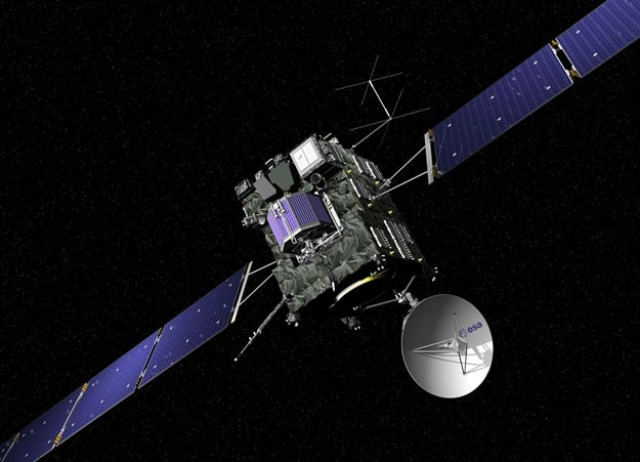'Time to say goodbye' to comet probe Philae: space agency
Philae's initial landing was bumpy -- lab bounced several times on surface before ending up at an angle in deep shade

This file image received from the European Space Agency (ESA) on February 6, 2004 shows a computer generated image of the ESA space probe "Rosetta" and its landing capsule "Philae". PHOTO: AFP
"There is indeed little hope to still get a signal from the lander," said Philae project manager Stephan Ulamec of the German Aerospace Center DLR.
The DLR, host of the Philae control centre, said the probe was "probably" covered with comet dust, and shaded from the Sun's battery-replenishing rays on the surface of its alien home.
"We are not commanding any more," Ulamec told AFP of the tiny probe, which captured the hearts and minds of thousands around the world who followed its every move via Twitter.
Gravitational waves: Why the fuss?
Mothership Rosetta, orbiting comet 67P/Churyomov-Gerasimenko as it shoots out on its 6.5-year loop around the Sun, will continue listening out for the washing machine-sized lander for a month or two to come.
"We still have the receivers on the orbiter on, we did not switch anything off... it's just to be honest and to be realistic: It's really not likely that we will hear anything any more," said Ulamec.
Philae touched down on 67P on November 12, 2014, after a 10-year, 6.5-billion-kilometre (four-billion-mile) journey through space, piggybacking on Rosetta as part of a groundbreaking European Space Agency (ESA) mission to probe a comet for clues to the origins of life on Earth.
The months that followed yielded many exciting scientific finds, and more than a little drama, as Philae intermittently phoned home between long bouts of sleep.
Scientists glimpse Einstein's gravitational waves
The lander "tweeted" about his adventures, also captured in a cartoon depicting Philae as a brave little adventurer with a hard hat and studded boots.
Philae's last contact from the surface of 67P was on July 9 last year, and by now the comet is thought to be too far out on its orbit for the lander to have enough energy to reboot.
In a statement entitled "A slow farewell - Time to say goodbye to Philae", the DLR said that out of the Sun's reach, the lander "will go into permanent hibernation -- no longer able to activate its systems in its cold environment."
Philae's initial landing was bumpy -- the lab bounced several times on the surface before ending up at an angle in deep shade.
CERN membership recognition of Pakistan’s achievements in science: Nawaz
It sent home data from about 60 hours of comet sniffing and prodding with eight of its 10 instruments, before going into standby mode on November 15, 2014.
In January this year, ground controllers sent commands for Philae to spin up its flywheel in the hopes it would shake dust from its solar panels and better align the robot with the Sun to charge its battery and re-establish two-way contact. The bid failed.
Rosetta will continue its comet observations until September, when it will make a controlled landing and join Philae on the surface of 67P in an endless loop around the Sun.
ESA senior science adviser Mark McCaughrean said the Philae mission cannot be officially declared over, as the absence of a signal does not prove the lander is actually dead.
"But the indications are certainly tending that way: it's getting cold, low sunlight, and less chance every day for renewed contact. After seven months or so without, I think the general consensus is that it's over."









1733130350-0/Untitled-design-(76)1733130350-0-208x130.webp)









COMMENTS
Comments are moderated and generally will be posted if they are on-topic and not abusive.
For more information, please see our Comments FAQ